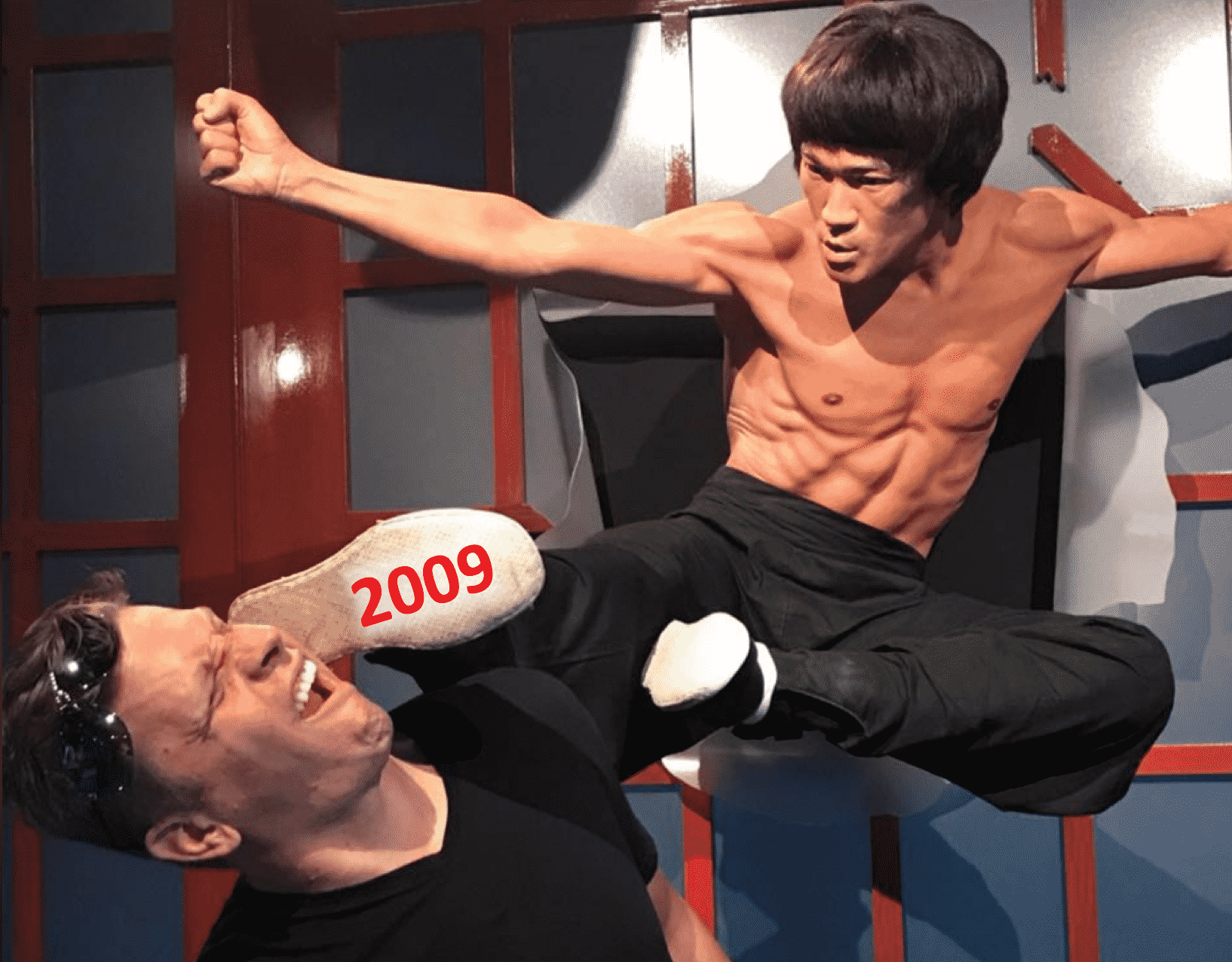My 26-year real estate career has experienced plenty of ups and downs. I have had the honor of being featured on the cover of REALTOR magazine, and also the embarrassment of filing a very public bankruptcy. Each time I failed, I got back up, dusted myself off, and rebuilt myself from the ashes of my mistakes.
The choice is yours to allow the setbacks and adversity in real estate to either empower you to break through to another level or to crush your real estate dreams and send you back to the security of a nine-to-five job. If you are someone who chooses to break through when you face adversity, the following eight steps to overcome setbacks and failure are here to guide you.
1. Learn to Accept Failure

I can tell you from personal experience that failure is part of achievement. Sure, I looked like a superstar when I earned over $1 million in commissions, received the Hall of Fame Award at RE/MAX, and was featured in multiple magazines for the success I had achieved. All this by the age of 30, but I have also faced massive adversity.
By the mid-2000s, I had heavily invested in rental properties across the nation. In fact, I had accumulated over 100 units. Then the Great Recession of 2009 hit. Like many real estate agents, my income dropped to less than one-third of what I had made the previous year. The properties that I had recently purchased no longer cash flowed, and I had to liquidate other investments to cover the increasing expenses. I held on as long as I could, but by 2010 I was broke, divorced, and emotionally exhausted.
Fortunately, I learned the techniques to overcome major setbacks that I am sharing with you today. I did not allow the failure to define me. Within two years, I had reinvented myself as an award-winning Team Leader (Managing Broker/Recruiter) for Keller Williams Realty, winning multiple awards for turning the office around during the recession. These achievements allowed me to launch my coaching career. As I reflect on my career today, I can clearly see that the setbacks and failures I faced all led to another level of success.
The higher you reach when you’re standing on the ladder to success, the greater chance you have to fall off the ladder. But that’s OK. Adversity is part of the process. There’s no achievement without setbacks and there’s no success without failure. That’s why learning to accept failure is the first step to overcome it.
2. Learn From Your Failures

As cliché as “learn from your failures” sounds, after experiencing several setbacks and failures in my life and career, I personally have learned the importance of taking the time to reflect on the lessons hidden deep within the failure, and I will show you how to do the same.
After your emotions have settled a little and you are ready to address your setback head-on, you can follow this three-step technique. This may take a little practice before you can effectively reflect on the experience without getting emotional or self-critical, but practice makes perfect.
The three-step process below is designed to help you capture the lessons within the failure.
Step 1: Separate yourself from the situation
Emotions can get in the way of clear thinking. Start by thinking about the situation as an experience that is separate from you. The plan was a failure, the execution was a failure—you are NOT a failure. You are a person who is learning through your experiences, that is all. Once you feel you can look at the experience from the perspective of an observer, you can move to step two.
Step 2: Engage your critical thinking
Once you have separated yourself from the experience, you can think of yourself as a coach who was not involved in the situation. Ask yourself questions to engage your critical thinking. Think about questions a coach would ask you about the setback. Without answering them, write out 10 to 20 questions that a coach might ask to learn more about the circumstance. Here is a short list of critical thinking questions to get you started.
- How do you feel you failed?
- How do you know this actually is a failure and not an obstacle?
- Have you given up too early?
- Were there earlier signs that you could have paid attention to?
- In what ways did you ignore your gut?
- Did you violate your personal values?
- How important is it for you to overcome this failure?
- How can you overcome this setback?
- What can you do to change the situation?
- What do you feel is the next step you should take?
Step 3: Answer the questions honestly
This is the difficult part. Without placing blame on other people or outside circumstances and without shaming or being overly critical of yourself, answer the earlier questions honestly. Just state the facts as you see them. Come from the mindset of wanting to learn from the experience so as not repeat it.
Once you have completed this step, it’s time to realign with your goals. The next technique is designed to get you back on track quickly.
3. Reorient Yourself With Your Goal

If you have ever experienced a serious setback or colossal failure, you may have noticed it felt a little like being shot out of a water slide into a deep pool of water. You probably found yourself disoriented, spinning, kicking, and reaching for something to guide you to the surface.
People don’t drown from water. They drown by not swimming, and the same is true with success. You don’t fail because of a setback—you fail by not getting back up and trying again. Like being disoriented underwater, you must reorient yourself quickly. These steps will get you back on track quickly.
First remind yourself what your original goal was. Specifically, what was it you originally wanted to achieve? Think of Peter Drucker’s S.M.A.R.T. goals. This is a way to make sure your goals are reachable and measurable.
- Specific: What exactly do you wish to achieve?
- Measurable: Can you measure it? How will you know when you have achieved it?
- Achievable: Can you achieve it in the given amount of time and resources?
- Realistic: You may want to own an NBA team, but is it realistic?
- Time: When do you wish to achieve it?
Thinking about your SMART goal, from a logical mindset, how far from the original goal are you really? You may be behind or even off track, but your past efforts and progress aren’t likely a total loss. Regain your focus and reorient yourself to your goal.
Once you have recalled your original intentions, next you will remind yourself of your motivation. From an emotional place, remind yourself why you set out to achieve the goal in the first place. Dig deep into your passion, purpose, and why. Here are some questions to ask yourself:
- How will achieving your goal affect your career?
- How will achieving your goal affect your family?
- How will achieving your goal affect your self-esteem?
- How will achieving your goal help your community?
- On a scale of 1-10, how important is it for you to achieve this goal?
Lastly, decide what is one thing you can do today to get yourself back on track. Remember, a journey of a thousand miles begins with a single step, and your journey of redemption begins with one thing you can do today.
Get some positive vibes going again by focusing on your clients. Send out a friendly email to your database, mail out three thank-you cards, or schedule an open house. Taking even a small action today will help your emotional state of mind, as you will learn about next.
4. Change Your Physical State

Failure can be crushing, embarrassing, and deflating. These feelings can zap your energy, leaving you lethargic and unmotivated. The real estate industry thrives on energy. Having low energy can be a death sentence for your career.
When I experienced my very public bankruptcy, literally published in the business section of the newspaper, I was so humiliated that it made me physically ill. I was so sick, I stayed in bed for nearly two weeks. There was no doubt in my mind that the stress of the bankruptcy caused the conditions in my body for the virus to thrive.
Motivational speaker Anthony Robbins teaches his students (yes, I am a past student) that “motion creates emotion,” and the fastest way to change your emotional state is by changing your physical state. You can learn more from Tony Robbins about how to use your body to change your emotions.
Our emotions have an influence over our physiology. When we feel sad, our energy is low; when we feel excited, our energy is high. Did you know that the reverse is also true? Physical movement can conversely affect our emotions.
To overcome the blues from my upsetting situation, I had to get out of bed. I decided no matter what, I would go for a walk each day, no matter how I felt. Some days were difficult, but over time, I began to look forward to the walks.
When you get your body in motion, your mind will follow. Commit to doing something physical each and every day to engage your body and change your emotions. Some simple physical activities are to take a walk, do some jumping jacks, or work on your garden.
In the next strategy to overcome adversity, you will learn how the story you tell yourself can empower your or tear you down.
5. Rewrite Your Story

Have you ever noticed that the stories we tell about a past situation also determine the emotions we feel about it? This is because the way we think about something determines our emotions, and the way we share our thinking is through our story.
I was taught this by the legendary retired real estate coach Dianna Kokoszka.
Earlier in my career, I had worked with Dianna at the same RE/MAX brokerage. She was the top producer and I was a noobie agent. Ten years later, I met her again by chance at a Keller Williams event, where she had become the President of MAPS Coaching and I was still licking my wounds from the recession.
Feeling like I had to justify my rise to success and noticeable failure, I began to share with her how the economy, my ex-wife, and other circumstances led to my current situation. I will never forget her response. She held my arm, looked me directly in the eyes, and said, “That is your story. Where does your story live?” Before I could respond, she answered herself, “It lives in your mind. Your story lives in your mind! You can rewrite your story.” She then pointed to a chair in the corner and said, “Go sit over there and rewrite an empowering story.”
Eager to change my circumstances, I sat in the chair and rewrote my story. A story that didn’t paint me as the victim and villainize other people or circumstances that are outside of my control. My new story took me from a helpless victim to a well-intentioned person who faced difficult adversity and made the decision to rise up again.
This simple but effective exercise allows me to reframe difficult experiences so they do not hold me back from living the life I desire. Once you rewrite your story, you must overcome the desire to compare yourself to others. Fortunately, we cover this next.
6. Don’t Compare Yourself to Others

When you face a setback—and you will—it’s a natural response to compare yourself to other people who are more successful. Because of this, comparing yourself to others can lead you down a never-ending path of negativity.
Our brains unconsciously point out to us the differences between products, services, other people, and ourselves. It helped our ancestors avoid predators, but today it can work against us and be one of the biggest obstacles to overcoming adversity. So when we compare ourselves with others, our brains will automatically point out the areas that we perceive ourselves as different or deficient. An example of this may sound like, “James has more experience than me and since I don’t have as much experience, I can’t be successful.”
Perceived deficiencies are often lies, born from cognitive dissonance, that we tell ourselves to justify our failure. These lies can be disempowering, demotivating, and hazardous to our mental well-being. More importantly, accepting these lies as truths prevents us from addressing the real issue and prevents you from achieving your potential in real estate.
Not to worry: If you find yourself drowning in the lies of perceived deficiencies, you can turn them around. Most of the time you will find that your perceived deficiency is not true. Write down the lie and ask yourself, “Is that true?”
Example:
Lie: “James has more experience than me and since I don’t have as much experience, I can’t be successful.”
Question: “Is that true?”
In the chart below, you can see how we took the comparison and identified the lie we are telling ourselves. Always remember you are comparing yourself to someone else’s highlight reel. Many successful people are dealing with serious problems also, or they have been through difficult situations that you can’t see.
Answer: “No, it is not true.”
Next, write out a truth that will empower you and move you to take action.
Truth: “Experience will come with time.”
In the chart below, we share a list of common comparisons, the corresponding lies we tell ourselves, and the empowering truths to allow you room for growth.
| Comparison | Lie | Truth |
|---|---|---|
| James has more experience. | I don’t have enough experience. | Experience will come with time. |
| Suzie has a better sphere of influence (SOI). | It is not fair that I don’t have an SOI that refers me. | Suzie takes the time to develop and communicate to her sphere. I can invest more time into my SOI. |
| Aliza has more money to spend on advertising. | I can’t be successful because I don’t have the money to advertise. | There are many ways to find and develop leads that cost little to no money. I can focus on those techniques. |
| Keith is better than me. | I am not good enough. | My skills will develop with practice. |
It is easy in real estate to compare yourself to others. The new skill of rewriting your comparisons into actionable truths is the most effective way I have found to overcome the lies that are holding me back. In the next section, you will learn more about writing your thoughts and journaling.
7. Manage Your Self-talk With Journaling

Believe it or not, the most powerful technique to managing your self-talk is journaling. The reason for this is difficult to comprehend, but I will do my best. In the book “Untethered Soul,” author Michael Singer proposes the hypothesis that we are not our thoughts.
Singer suggests that we couldn’t have the ability to have a conversation with ourselves and listen at the same time. Since we all have the ability to weigh options and question our assumptions, then we must not be the one having the conversation. Singer says we are the one who observes, listens, decides, and takes action—not the thought itself.
If you choose to take the leap and believe in Singer’s philosophy, then journaling allows you to write out your thoughts, beliefs, and assumptions. Examine them from a critical perspective before accepting them.
There are no secret tricks to journaling; simply keep a journal with you and take five to 10 minutes each day to write out your thoughts. Review them, question them, and decide if they are serving you and your goals or if they should be erased and replaced with more empowering thoughts or beliefs. Over time, journaling will become more natural as you become clearer about your beliefs and personal preferences.
8. Find Meaning in Your Suffering

Real estate is full of opportunity and risk. My wish for you is that you take chances and reach for the stars. But if you happen to fail, you may be able to find a higher meaning in your failure. Many highly successful people, like Maya Angelou, have found their passion from their struggles.
In the book “Man’s Search for Meaning” by Viktor Frankl, the author states that “suffering ceases to be suffering at the moment it finds a meaning.” I have found this to be true for myself too. The experiences you have gained and the lessons you have learned are important teachings for others.
Frankl also said, “If there is meaning in life at all, then there must be meaning in suffering.” Find the lessons in your adversity, find your passion, and share your lessons with others so they don’t experience the pain and suffering that you endured.
In the end, you might discover, like I have, that you find enjoyment in helping others achieve success, even more than achieving success for yourself.
Congratulations, It Didn’t Kill You—It Made You Stronger!
It is true: I have failed. I have also bounced back by using these steps to not only overcome, but to break through to the next level. Adversity in my life has led me on a path to have a more full and purposeful life. You can help me create meaning in my suffrage by learning from my long history of setbacks and failures. A smart person learns from their own mistakes, a genius learns from other’s mistakes. Be a genius and learn to recover quickly from setbacks and adversity.
Over to You
Do you have a tip to overcome setbacks that we didn’t mention here? Let us know in the comments, or if you’re an active agent, join our Facebook mastermind group here.




Add comment